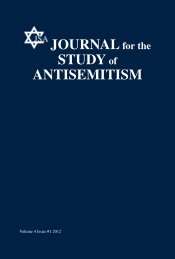JOURNALfor the STUDYof ANTISEMITISM
JOURNALfor the STUDYof ANTISEMITISM
JOURNALfor the STUDYof ANTISEMITISM
You also want an ePaper? Increase the reach of your titles
YUMPU automatically turns print PDFs into web optimized ePapers that Google loves.
2011] <strong>ANTISEMITISM</strong> IN WAGNERIAN OPERA 251<br />
some, honest, virtuous, and brave, and whose most significant flaw is that<br />
he is too trusting of strangers.<br />
It is often argued that every representation of a negative physical characteristic<br />
should not automatically be interpreted as an antisemitic statement.<br />
This is a perceptive and valuable criticism, but not as applied to <strong>the</strong>se<br />
five specifics, none of which are in <strong>the</strong> least extreme. As Paul Lawrence<br />
Rose said in Wagner: Race and Revolution, “If Wagner, with <strong>the</strong> supreme<br />
artist’s infallible intuition, never intruded his racialist <strong>the</strong>ories into his<br />
works of art, this does not mean that <strong>the</strong> art is free of racist content. It<br />
simply means that Wagner was too subtle an artist to reduce his operas to<br />
<strong>the</strong> level of political tracts.”<br />
While it would be possible to level a criticism of overreaction were<br />
<strong>the</strong>re to be only one or two instances where Wagner’s utterances could be<br />
confused with coded antisemitic statements, <strong>the</strong> presence of five specifics—<br />
feet, smell, voice, sight, and race mixing, as found in three of <strong>the</strong> four<br />
operas of The Ring—defies <strong>the</strong> laws of probability. I suggest that The Ring,<br />
with <strong>the</strong> exception of Valkyrie, is an anthology of Jew hatred from first note<br />
to last.<br />
NON-WAGNER OPERAS<br />
O<strong>the</strong>r than Wagner, negative stereotypes of Jews in opera are rare.<br />
Richard Strauss’s portrayal of five Jews in Salome shows quarreling, complaining,<br />
and whining men. Fur<strong>the</strong>rmore, four of <strong>the</strong> Jews are high tenors,<br />
which gives an especially shrill quality to <strong>the</strong>ir singing. As Sander Gilman<br />
has pointed out, 12 in <strong>the</strong> latter part of <strong>the</strong> nineteenth century, high voices<br />
were associated with castration, which, in <strong>the</strong> mind of <strong>the</strong> ill informed, was<br />
synonymous with circumcision. 13<br />
Sergei Prokofiev’s opera, Betrothal in a Monastery (La Duenna),<br />
based on an eighteenth-century play, La Duenna, by Richard Brinsley Sheridan<br />
(1751-1816), contains <strong>the</strong> individual, Isaac Mendoza, a Jew portrayed<br />
in a negative fashion. But this would be very much out of character for<br />
Prokofiev, who was not an antisemite. His Overture on Yiddish Themes was<br />
written in New York for his conservatory colleagues in <strong>the</strong> touring Jewish<br />
12. Sander Gilman is Distinguished Professor of <strong>the</strong> Liberal Arts and Sciences<br />
at Emory University, where he is <strong>the</strong> director of <strong>the</strong> Program in Psychoanalysis as<br />
well as <strong>the</strong> University’s Health Sciences Humanities Initiative. In 2007 he was<br />
appointed professor, Institute in <strong>the</strong> Humanities, Birkbeck College (London) and a<br />
visiting fellow of <strong>the</strong> new Institute of Advanced Studies, Warwick University, UK.<br />
13. Sander Gilman, The Jew’s Body (New York: Routledge, Chapman, and<br />
Hall, 1991).














